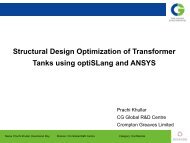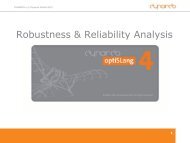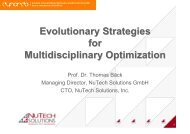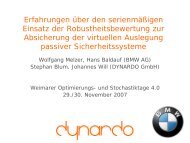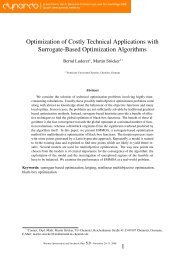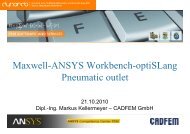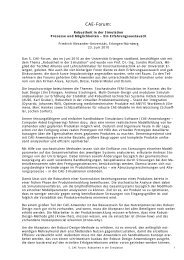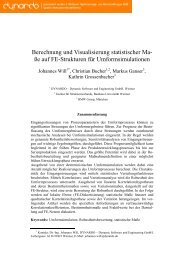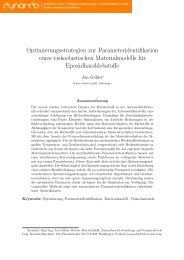Recent developments in the Metamodel of Optimal ... - Dynardo GmbH
Recent developments in the Metamodel of Optimal ... - Dynardo GmbH
Recent developments in the Metamodel of Optimal ... - Dynardo GmbH
Create successful ePaper yourself
Turn your PDF publications into a flip-book with our unique Google optimized e-Paper software.
WOST 2011 • 24.– 25.11.2011 • © <strong>Dynardo</strong> <strong>GmbH</strong> 2011<br />
<strong>Recent</strong> <strong>developments</strong> <strong>in</strong> <strong>the</strong><br />
<strong>Metamodel</strong> <strong>of</strong> <strong>Optimal</strong> Prognosis<br />
Thomas Most & Johannes Will<br />
<strong>Dynardo</strong> <strong>GmbH</strong><br />
<strong>Recent</strong> <strong>developments</strong> <strong>in</strong> <strong>the</strong> <strong>Metamodel</strong> <strong>of</strong> <strong>Optimal</strong> Prognosis<br />
Thomas Most & Johannes Will<br />
1
WOST 2011 • 24.– 25.11.2011 • © <strong>Dynardo</strong> <strong>GmbH</strong> 2011<br />
Introduction<br />
• Start<strong>in</strong>g <strong>in</strong> 2008 <strong>the</strong> <strong>Metamodel</strong> <strong>of</strong> <strong>Optimal</strong> Prognosis has become an<br />
important feature <strong>in</strong> optiSLang’s sensitivity analysis, optimization and<br />
robustness analysis<br />
• The ma<strong>in</strong> priorities <strong>of</strong> <strong>the</strong> MOP methodology are:<br />
• Detection <strong>of</strong> <strong>the</strong> important variable subspace<br />
• Usage <strong>of</strong> understandable, reproducible and fast<br />
approximation models<br />
• Objective estimation <strong>of</strong> <strong>the</strong> approximation quality<br />
• However, some questions need to be discussed:<br />
• May more complex meta-models significantly improve <strong>the</strong><br />
approximation quality?<br />
• How can we adapt <strong>the</strong> MOP to perform optimal <strong>in</strong> <strong>the</strong> framework<br />
<strong>of</strong> an optimization problem?<br />
<strong>Recent</strong> <strong>developments</strong> <strong>in</strong> <strong>the</strong> <strong>Metamodel</strong> <strong>of</strong> <strong>Optimal</strong> Prognosis<br />
Thomas Most & Johannes Will<br />
2
WOST 2011 • 24.– 25.11.2011 • © <strong>Dynardo</strong> <strong>GmbH</strong> 2011<br />
Polynomial regression<br />
• Set <strong>of</strong> <strong>in</strong>put variables<br />
• Def<strong>in</strong>ition <strong>of</strong> polynomial basis<br />
• Approximation function<br />
• Least squares solution<br />
<strong>Recent</strong> <strong>developments</strong> <strong>in</strong> <strong>the</strong> <strong>Metamodel</strong> <strong>of</strong> <strong>Optimal</strong> Prognosis<br />
Thomas Most & Johannes Will<br />
3
WOST 2011 • 24.– 25.11.2011 • © <strong>Dynardo</strong> <strong>GmbH</strong> 2011<br />
Coefficient <strong>of</strong> Determ<strong>in</strong>ation (CoD)<br />
• Fraction <strong>of</strong> expla<strong>in</strong>ed variation<br />
<strong>of</strong> an approximated response<br />
• Total variation<br />
• Unexpla<strong>in</strong>ed variation<br />
• Adjusted CoD<br />
to penalize over-fitt<strong>in</strong>g<br />
<strong>Recent</strong> <strong>developments</strong> <strong>in</strong> <strong>the</strong> <strong>Metamodel</strong> <strong>of</strong> <strong>Optimal</strong> Prognosis<br />
Thomas Most & Johannes Will<br />
4
WOST 2011 • 24.– 25.11.2011 • © <strong>Dynardo</strong> <strong>GmbH</strong> 2011<br />
Limitations <strong>of</strong> <strong>the</strong> CoD<br />
• CoD is only based on how good <strong>the</strong> regression model fits through <strong>the</strong><br />
sample po<strong>in</strong>ts, but not on how good <strong>the</strong> prediction quality is<br />
• Approximation quality is too optimistic for small number <strong>of</strong> samples<br />
• For <strong>in</strong>terpolation models with perfect fit, CoD is equal to one<br />
• Better approximation models are required for highly nonl<strong>in</strong>ear<br />
problems, but CoD works only with polynomials<br />
<strong>Recent</strong> <strong>developments</strong> <strong>in</strong> <strong>the</strong> <strong>Metamodel</strong> <strong>of</strong> <strong>Optimal</strong> Prognosis<br />
Thomas Most & Johannes Will<br />
5
WOST 2011 • 24.– 25.11.2011 • © <strong>Dynardo</strong> <strong>GmbH</strong> 2011<br />
Mov<strong>in</strong>g Least Squares (MLS)<br />
• Local polynomial regression with<br />
position-dependent coefficients<br />
• Distance depend<strong>in</strong>g weight<strong>in</strong>g function<br />
• Smooth<strong>in</strong>g <strong>of</strong> approximation is<br />
controlled by weight<strong>in</strong>g radius D<br />
• Choice <strong>of</strong> D directly <strong>in</strong>fluences <strong>the</strong> CoD<br />
<strong>Recent</strong> <strong>developments</strong> <strong>in</strong> <strong>the</strong> <strong>Metamodel</strong> <strong>of</strong> <strong>Optimal</strong> Prognosis<br />
Thomas Most & Johannes Will<br />
6
WOST 2011 • 24.– 25.11.2011 • © <strong>Dynardo</strong> <strong>GmbH</strong> 2011<br />
Coefficient <strong>of</strong> Prognosis (CoP)<br />
• Fraction <strong>of</strong> expla<strong>in</strong>ed variation<br />
<strong>of</strong> prediction<br />
• Estimation <strong>of</strong> CoP by cross<br />
validation us<strong>in</strong>g a partition<strong>in</strong>g<br />
<strong>of</strong> available <strong>the</strong> samples<br />
• CoP <strong>in</strong>creases with <strong>in</strong>creas<strong>in</strong>g number <strong>of</strong> samples<br />
• CoP is suitable for <strong>in</strong>terpolation and regression models<br />
• With MLS cont<strong>in</strong>uous functions also <strong>in</strong>clud<strong>in</strong>g coupl<strong>in</strong>g terms<br />
can be represented with a certa<strong>in</strong> number <strong>of</strong> samples<br />
• Prediction quality is better if unimportant variables are removed<br />
from <strong>the</strong> approximation model<br />
<strong>Recent</strong> <strong>developments</strong> <strong>in</strong> <strong>the</strong> <strong>Metamodel</strong> <strong>of</strong> <strong>Optimal</strong> Prognosis<br />
Thomas Most & Johannes Will<br />
7
WOST 2011 • 24.– 25.11.2011 • © <strong>Dynardo</strong> <strong>GmbH</strong> 2011<br />
<strong>Metamodel</strong> <strong>of</strong> <strong>Optimal</strong> Prognosis (MOP)<br />
• Approximation <strong>of</strong> solver output by fast surrogate model<br />
• Reduction <strong>of</strong> <strong>in</strong>put space to get best compromise between available<br />
<strong>in</strong>formation (samples) and model representation (number <strong>of</strong> <strong>in</strong>puts)<br />
• Advanced filter technology to obta<strong>in</strong> candidates <strong>of</strong> optimal subspace<br />
• Determ<strong>in</strong>ation <strong>of</strong> optimal approximation model (polynomials, MLS, …)<br />
• Assessment <strong>of</strong> approximation quality (CoP)<br />
MOP solves 3 important tasks:<br />
• Best variable subspace<br />
• Best meta-model<br />
• Estimation <strong>of</strong> prediction quality<br />
<strong>Recent</strong> <strong>developments</strong> <strong>in</strong> <strong>the</strong> <strong>Metamodel</strong> <strong>of</strong> <strong>Optimal</strong> Prognosis<br />
Thomas Most & Johannes Will<br />
8
WOST 2011 • 24.– 25.11.2011 • © <strong>Dynardo</strong> <strong>GmbH</strong> 2011<br />
Example: Analytical nonl<strong>in</strong>ear function<br />
• Additive l<strong>in</strong>ear and nonl<strong>in</strong>ear terms and one coupl<strong>in</strong>g term<br />
• Contribution to <strong>the</strong> output variance (reference values):<br />
X 1 : 18.0%, X 2 : 30.6%, X 3 : 64.3%, X 4 : 0.7%, X 5 : 0.2%<br />
<strong>Recent</strong> <strong>developments</strong> <strong>in</strong> <strong>the</strong> <strong>Metamodel</strong> <strong>of</strong> <strong>Optimal</strong> Prognosis<br />
Thomas Most & Johannes Will<br />
9
WOST 2011 • 24.– 25.11.2011 • © <strong>Dynardo</strong> <strong>GmbH</strong> 2011<br />
Example: Analytical nonl<strong>in</strong>ear function<br />
MOP vs. Polynomials & MLS<br />
• 100 LHS support po<strong>in</strong>ts<br />
• Expla<strong>in</strong>ed variation <strong>of</strong> <strong>in</strong>dependent test data<br />
set with 100 samples as error measure<br />
• With <strong>in</strong>creas<strong>in</strong>g number <strong>of</strong> unimportant variables <strong>the</strong> approximation<br />
error <strong>in</strong>creases for polynomials and MLS<br />
• MOP detects 3 important variables<br />
<strong>Recent</strong> <strong>developments</strong> <strong>in</strong> <strong>the</strong> <strong>Metamodel</strong> <strong>of</strong> <strong>Optimal</strong> Prognosis<br />
Thomas Most & Johannes Will<br />
10
WOST 2011 • 24.– 25.11.2011 • © <strong>Dynardo</strong> <strong>GmbH</strong> 2011<br />
Example: Analytical nonl<strong>in</strong>ear function<br />
MOP vs. Krig<strong>in</strong>g<br />
• Krig<strong>in</strong>g optimized with maximum likelihood will not always give <strong>the</strong><br />
optimal correlation parameters<br />
• For certa<strong>in</strong> number <strong>of</strong> <strong>in</strong>puts Krig<strong>in</strong>g seems to be more suitable than<br />
Mov<strong>in</strong>g Least Squares<br />
<strong>Recent</strong> <strong>developments</strong> <strong>in</strong> <strong>the</strong> <strong>Metamodel</strong> <strong>of</strong> <strong>Optimal</strong> Prognosis<br />
Thomas Most & Johannes Will<br />
11
WOST 2011 • 24.– 25.11.2011 • © <strong>Dynardo</strong> <strong>GmbH</strong> 2011<br />
Example: Analytical nonl<strong>in</strong>ear function<br />
MOP vs. Support Vector Regression & Artificial Neural Networks<br />
• SVR and ANN require much more effort for tra<strong>in</strong><strong>in</strong>g<br />
• ANN approximation quality strongly decreases with <strong>in</strong>creas<strong>in</strong>g dimension<br />
• Krig<strong>in</strong>g approximation seems to be similar or even more accurate<br />
<strong>Recent</strong> <strong>developments</strong> <strong>in</strong> <strong>the</strong> <strong>Metamodel</strong> <strong>of</strong> <strong>Optimal</strong> Prognosis<br />
Thomas Most & Johannes Will<br />
12
WOST 2011 • 24.– 25.11.2011 • © <strong>Dynardo</strong> <strong>GmbH</strong> 2011<br />
Example: Analytical nonl<strong>in</strong>ear function<br />
MOP vs. MATLAB’s stepwise regression<br />
• Stepwise regression selects coefficients <strong>of</strong> polynomial regression by<br />
statistical significance test<strong>in</strong>g<br />
• For a larger number <strong>of</strong> <strong>in</strong>puts F-test based MATLAB implementation<br />
performs only well if l<strong>in</strong>ear terms are considered<br />
<strong>Recent</strong> <strong>developments</strong> <strong>in</strong> <strong>the</strong> <strong>Metamodel</strong> <strong>of</strong> <strong>Optimal</strong> Prognosis<br />
Thomas Most & Johannes Will<br />
13
WOST 2011 • 24.– 25.11.2011 • © <strong>Dynardo</strong> <strong>GmbH</strong> 2011<br />
New implementation <strong>of</strong> MOP<br />
• Implementation based on state-<strong>of</strong>-<strong>the</strong>-art algebra library<br />
• Parallel comput<strong>in</strong>g will be <strong>in</strong>troduced at several levels (research project <strong>in</strong><br />
cooperation with Fraunh<strong>of</strong>er ITWM founded by KMU-<strong>in</strong>novativ/BMBF)<br />
• Efficient CoP implementation enables very fast test<strong>in</strong>g<br />
– Analytical estimator for polynomials with Box-Cox<br />
– No extra computational effort for MLS<br />
• New filter technology for <strong>the</strong> detection <strong>of</strong> <strong>in</strong>teraction terms between<br />
<strong>in</strong>put variables <strong>in</strong> high dimensional problems<br />
• Hierarchical model test<strong>in</strong>g to reduce overall computational effort and to<br />
enable more time consum<strong>in</strong>g models such as Krig<strong>in</strong>g<br />
<strong>Recent</strong> <strong>developments</strong> <strong>in</strong> <strong>the</strong> <strong>Metamodel</strong> <strong>of</strong> <strong>Optimal</strong> Prognosis<br />
Thomas Most & Johannes Will<br />
14
WOST 2011 • 24.– 25.11.2011 • © <strong>Dynardo</strong> <strong>GmbH</strong> 2011<br />
Sensitivity analysis vs. optimization us<strong>in</strong>g MOP<br />
• MOP is build by equally weight<strong>in</strong>g <strong>the</strong> prediction errors:<br />
• This is optimal for sensitivity analysis s<strong>in</strong>ce global variance-based<br />
measures (s<strong>in</strong>gle variable CoPs) are most accurate with equal weights<br />
• Optimization requires good approximation quality <strong>of</strong> objective and<br />
constra<strong>in</strong>t functions <strong>in</strong> <strong>the</strong> region around <strong>the</strong> optimum<br />
� Weight<strong>in</strong>g <strong>of</strong> prediction errors to improve <strong>the</strong> MOP based optimization<br />
• Extrapolation <strong>of</strong> approximation function <strong>of</strong>ten looses accuracy<br />
� Additional constra<strong>in</strong>t to consider approximation quality<br />
<strong>Recent</strong> <strong>developments</strong> <strong>in</strong> <strong>the</strong> <strong>Metamodel</strong> <strong>of</strong> <strong>Optimal</strong> Prognosis<br />
Thomas Most & Johannes Will<br />
15
WOST 2011 • 24.– 25.11.2011 • © <strong>Dynardo</strong> <strong>GmbH</strong> 2011<br />
Example: Rosenbrock function<br />
Optimization us<strong>in</strong>g MOP<br />
• Optimum at 1.0;1.0<br />
• Best design from 500 LHS<br />
samples at 0.5;0.3<br />
• Global CoP is 99.996%<br />
• Optimum found on MOP<br />
approximation at 1.7;3.0<br />
• Approximation is globally very<br />
good but locally not sufficient:<br />
� Weighted CoP is 73.24%<br />
(with <strong>the</strong> samples f≤20)<br />
� Choice <strong>of</strong> optimal <strong>in</strong>fluence<br />
radius needs to consider<br />
local/weighted CoP<br />
<strong>Recent</strong> <strong>developments</strong> <strong>in</strong> <strong>the</strong> <strong>Metamodel</strong> <strong>of</strong> <strong>Optimal</strong> Prognosis<br />
Thomas Most & Johannes Will<br />
16
WOST 2011 • 24.– 25.11.2011 • © <strong>Dynardo</strong> <strong>GmbH</strong> 2011<br />
Example: Rosenbrock function<br />
Optimization us<strong>in</strong>g Krig<strong>in</strong>g<br />
• Global CoP is 99.999%<br />
• Optimum found on Krig<strong>in</strong>g<br />
approximation at 1.1;1.2<br />
• Weighted CoP is 99.912%<br />
(with <strong>the</strong> samples f≤20)<br />
<strong>Recent</strong> <strong>developments</strong> <strong>in</strong> <strong>the</strong> <strong>Metamodel</strong> <strong>of</strong> <strong>Optimal</strong> Prognosis<br />
Thomas Most & Johannes Will<br />
17
WOST 2011 • 24.– 25.11.2011 • © <strong>Dynardo</strong> <strong>GmbH</strong> 2011<br />
Conclusions<br />
• CoP based detection <strong>of</strong> important variables enables application <strong>of</strong> MOP<br />
for high-dimensional <strong>in</strong>dustrial problems<br />
• Us<strong>in</strong>g <strong>the</strong> optimal subspace is <strong>of</strong>ten more promis<strong>in</strong>g than us<strong>in</strong>g<br />
highly complex approximation models<br />
• New implementation will significantly accelerate MOP approach and<br />
enables <strong>the</strong> consideration <strong>of</strong> more time consum<strong>in</strong>g models (Krig<strong>in</strong>g)<br />
• New filter technology will improve <strong>the</strong> variable detection<br />
• Optimization requires special strategies<br />
• Weighted CoP to get best approximation around <strong>the</strong> optimum<br />
• Consideration <strong>of</strong> local approximation quality <strong>in</strong> optimization method<br />
<strong>Recent</strong> <strong>developments</strong> <strong>in</strong> <strong>the</strong> <strong>Metamodel</strong> <strong>of</strong> <strong>Optimal</strong> Prognosis<br />
Thomas Most & Johannes Will<br />
18




